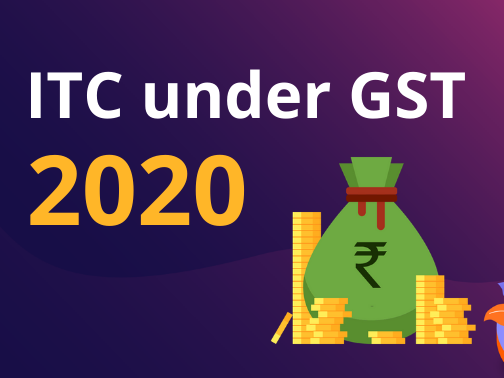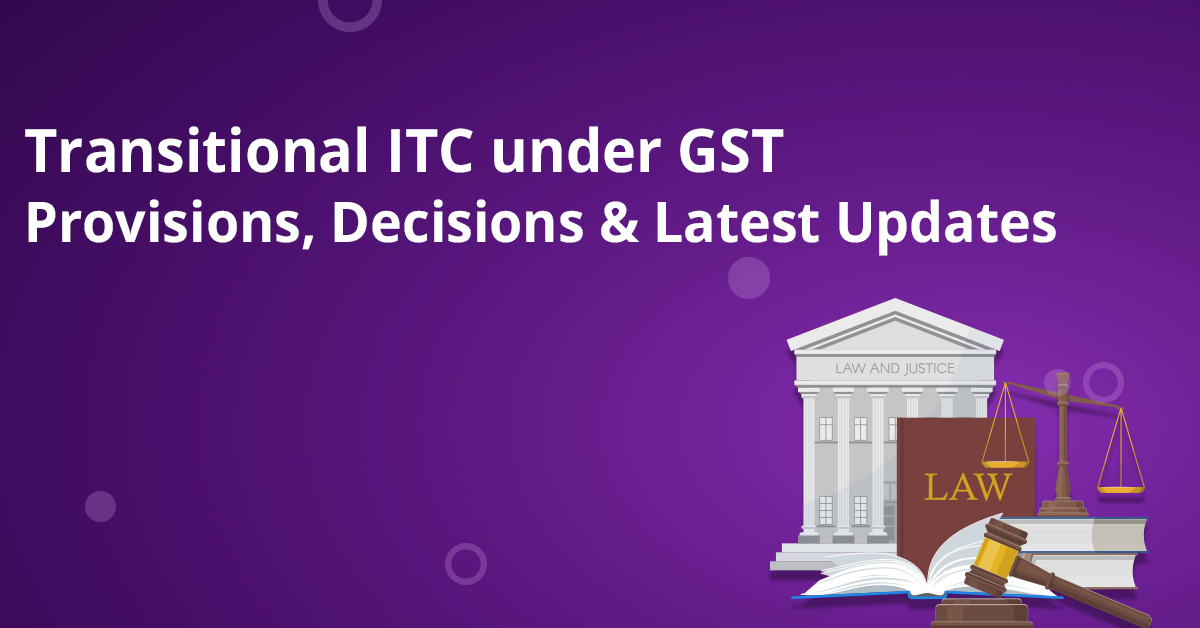

One essential aspect of business taxation in India is Input Tax Credit under GST. It helps in identifying the most accurate tax value & avoids the screening effect on taxes.
ITC under GST is one way of avoiding the payment of excess tax or repetition of taxes on goods or services. Because of its monetary benefits, businesses focus on ITC and its provisions keenly.
In this article, we have covered all the major, latest updates & changes made to Input Tax Credit under GST.

Input Tax Credit under GST- Meaning & Definition
Input Tax Credit or ITC under GST is the component of the GST regime that enables taxpayers to pay the most precise amount of tax on goods or supplies.
ITC is the credit of the tax that you already paid in the making of a good or service as an input in the finished good. So, when you sell the finished good you will not have to pay the same tax twice since you already paid it while manufacturing the goods.
When you purchase raw material from a supplier, they will declare that sale in their GSTR-1 (sales return) & the same will reflect in your GSTR-2A (purchase return).
Using this record you can claim the input tax credit through for GSTR-3B.
ITC can be claimed on any type of inward supply, including exports & supplies liable to Reverse Charge Mechanism. You can also claim the credits on assets & capital goods if you do not claim the depreciation on the same.
Although the government has restricted some cases & transactions on which ITC remains blocked, click here to check out the list of cases, goods & services where ITC remains ineligible.
But what happens if the supplier does not declare or wrongly declares the invoices of their sale to you?
In such cases, you can still claim the credits, but it will be called provisional credit instead of ITC.
Earlier taxpayers were allowed to claim 100% PC, if the recipient had all the valid supporting documents, however, this has been capped to a smaller %age since December 2019.
Illustration on working of ITC under GST-
Mr. A purchases leather material for his leather bag business at a 12% GST rate from Mr. B. The total tax that he paid to Mr. B was Rs. 20,000.
On his finished leather bags, Mr. A was liable to pay at a 28% GST rate of Rs. 80,000.
Now, when Mr. B declares the sale of the leather material in his GSTR-1 it will reflect in the purchase return GSTR-2A of Mr. A.
Based on this GSTR-2A record, he can claim the amount of Rs. 20,000 that he already paid on the input of the product & adjust it with his tax liabilities.
After claiming the ITC, MR. A will only have to pay Rs. 60,000 as his tax liability.
List of Provisions & Changes made to ITC under GST
We have prepared a list of some of the most important updates & changes made to input tax credit under GST, and have explained its working & provisions below-
The 10% provisional Credit Rule- This was one of the most important rules that rolled out under GST. Before this rule, taxpayers were allowed to claim 100% credit on the transactions that were not disclosed by the supplier, or that had invoices missing from the supplier end. However as per Notification no. 75/2019, now, the taxpayers can claim only 10% of the eligible ITC as Provisional Credit.
Meaning, if you are eligible for ITC amount Rs. 10,000 a per your GSTR-2A but Rs. 23,000 as per your purchase record, you will only be allowed to claim Rs. 10,000 + Rs. 1,000 (10% of eligible ITC) as provisional credit.
Halting of the 10% Provisional Credit Rule- Looking at the financial & economical damage caused to the country & businesses due to the pandemic & the lockdown, the government has decided to compensate & help businesses. As per Notification No. 30/2020- Central tax, the government has temporarily abolished the 10% ITC rule from Feb 2020 to August 2020. In other words, taxpayers can claim 100% provisional credits even for inward supplies with missing invoices from the supplier's end.

Transitional ITC under GST- Transitional Input Tax Credit under GST has been a highly controversial & problematic subject ever since the implementation of the GST regime. Transitional credit or Transitional ITC under GST is the amount of ITC on transactions that were carried out before the implementation of the GST regime. You need to file forms GST TRAN-1, GST TRAN-2 & GST TRAN-3 in order to claim the transitional ITC.
There have been controversies about Section 140 of the CGST Act & Rule no. 117 of the CGST Rules, concerning the taxpayers that the rule is ultra vires, irrelevant, & violates Article 14 of the constitution.
Rule 117 of the CGST Rules, binds a certain time frame to claim the transitional ITC & many taxpayers have been against the same.
However, the Hon’ble High & Supreme Court have given their verdicts on multiple cases, stating Rule 117 as completely valid & that it shall stay intact.
Rule 117 of the CGST Rule stated a specified timeline to claim the transitional credits & laid down other rules in the same context. The rule also sets an extended date (March 31st, 2020) for all taxpayers who could not file form Tran-1 due to a technical glitch.
Refund of unutilized ITC under inverted duty structure- Taxpayers will not be allowed to claim the refund of unutilized ITC under inverted duty structure, where the GST rate on the same goods has changed.
Refund of ITC on supplies other than zero-rated supplies- As per Notification No.16/2020-Central Tax dated 23.03.2020, sub-rule (4A) has been inserted in rule 86 of the CGST Rules, 2017 and sub-rule (1A) has also been inserted in rule 92.
These new rules lay down a few changes in the refund claim process for supplies other than zero-rated supplies. Before these rules were implemented, the entire refund amount was credited to the taxpayer in cash, which raised issues as some of the tax was paid by the taxpayers through electronic credit ledger.
But after the implementation of these new rules, the taxpayers will receive their refunds in a proportionately segregated form, that is, the tax paid through the electronic cash ledger will be refunded to the electronic cash ledger & whereas the tax paid viz electronic credit ledger will be refunded to the electronic credit ledger.
HSN/SAC wise disclosure in Anx-B for a refund of Utilized ITC- As per Circular no 135/05/2020 dated 31.03.2020, taxpayers will have to declare HSN/SAC wise details of the invoices of supplies of goods & services, in Annexure-B Statement of invoices to be submitted with the application for refund of unutilized ITC, while claiming the refund of unutilized GST.
This rule was implemented since the HSN wise details are missing in GSTR-2A it becomes difficult for the tax officials to distinguish between ITC on capital goods and/or input services out of total ITC in a particular tax period.
Hence it is recommended to add a column relating to HSN/SAC Code in the statement of invoices relating to inward supply as provided in Annexure–B of the Circular No. 125/44/2019-GST dated 18.11.2019 to easily distinguish between the supplies of goods and services.
Disclaimer: The contents of this document are solely for informational purpose. It does not constitute professional advice or a formal recommendation. While due care has been taken in preparing this document, the existence of mistakes and omissions herein is not ruled out. Neither the author nor Tax Ninja and its affiliates accepts any liabilities for any loss or damage of any kind arising out of any inaccurate or incomplete information in this document nor for any actions taken in reliance thereon.